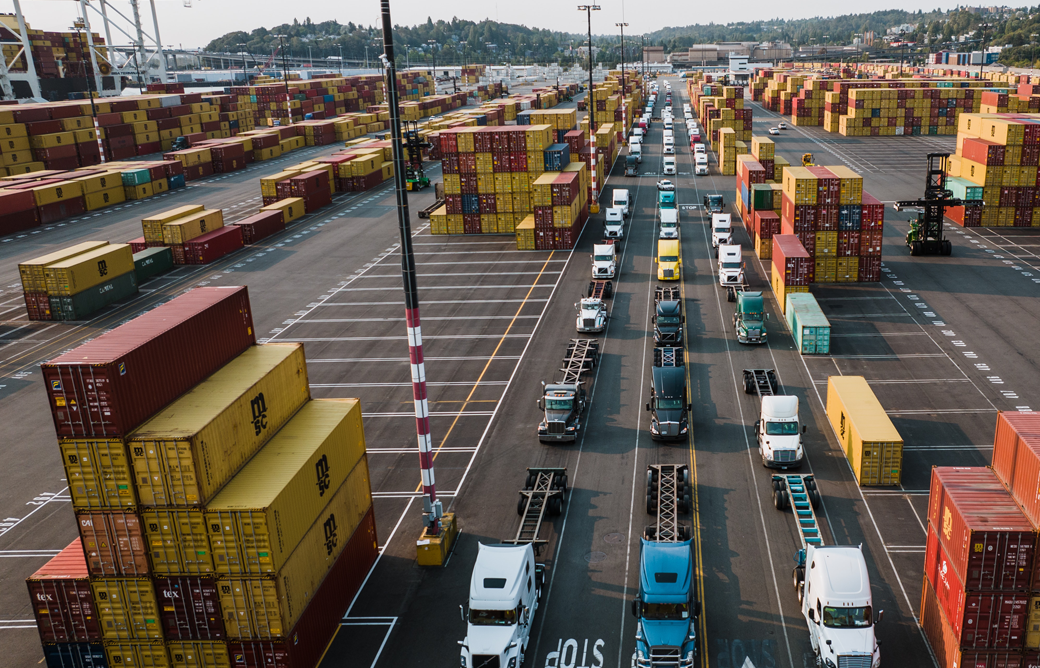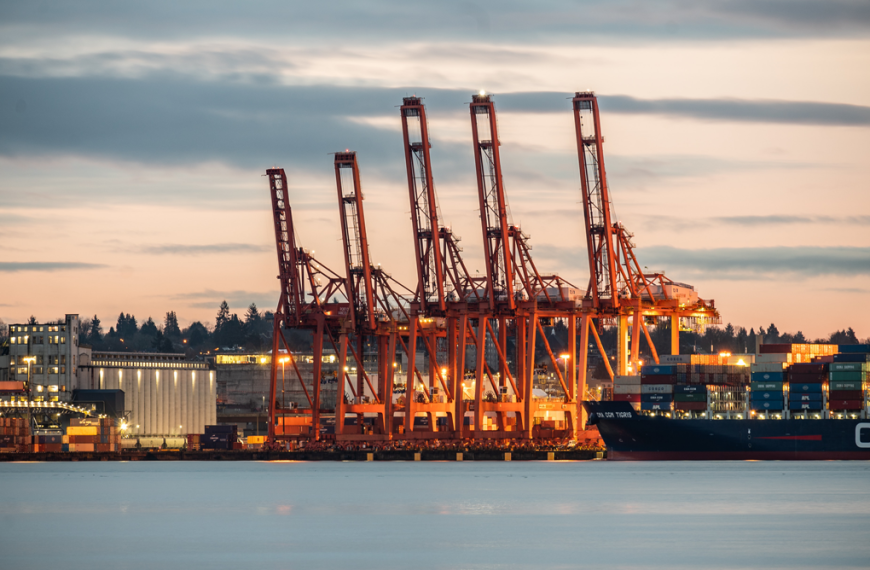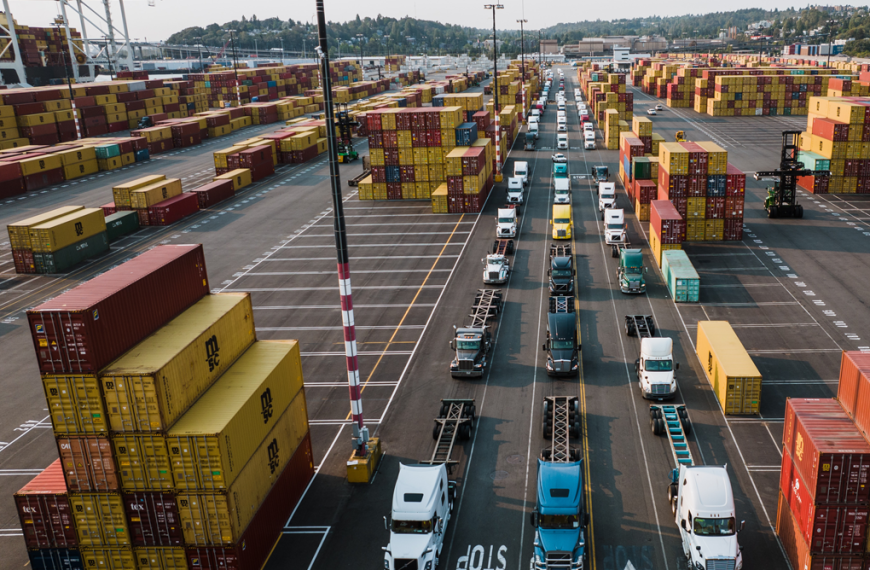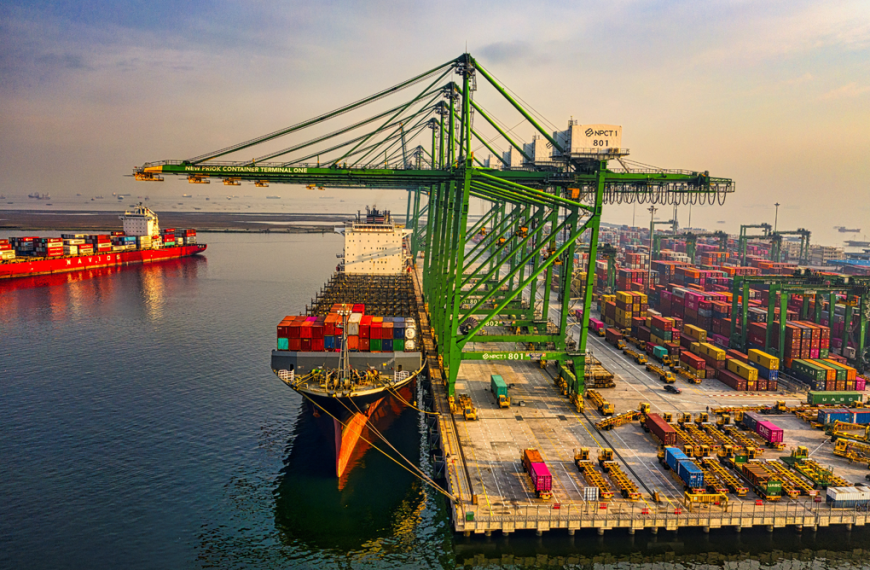Discover the power of digital freight forwarding in streamlining global logistics. Unlock efficiency and security with innovative solutions. In today’s hyper-connected world, the global logistics industry is evolving at a rapid pace. Traditional methods of freight transportation are being revolutionized by the advent of digital freight forwarding. This innovative approach is becoming the ultimate weapon for businesses seeking to gain a competitive edge in the fiercely competitive landscape of global logistics.
- What is Digital Freight Forwarding?
- Streamlining Global Supply Chains: Unleashing the Power of Digital Freight Forwarding
- Real-Time Tracking and Visibility: Empowering Global Logistics with Digital Freight Forwarding
- Automation and Efficiency: Revolutionizing Global Logistics with Digital Freight Forwarding
- Unleashing the Power of Data Analytics and Predictive Insights in Digital Freight Forwarding
- Overcoming Challenges and Embracing Future Trends in Digital Freight Forwarding
- Challenges in Digital Freight Forwarding
- Future Trends in Digital Freight Forwarding
- Embracing the Future of Digital Freight Forwarding
- Frequently Asked Questions (FAQs)
- Related Articles
What is Digital Freight Forwarding?
Digital freight forwarding is a cutting-edge strategy that combines advanced technology with the expertise of freight forwarders to streamline and optimize the transportation of goods across the globe. It encompasses a range of digital tools, platforms, and processes that revolutionize the way businesses handle freight logistics, ensuring efficiency, security, and cost-effectiveness throughout the supply chain.
Advantages of Digital Freight Forwarding
- Enhanced Freight Transportation Security: In an era where cargo security is of utmost importance, digital freight forwarding takes center stage. With robust tracking systems, secure data exchange, and adherence to stringent regulations, businesses can rest assured knowing that their shipments are protected at every step of the journey.
- Efficient Freight Brokerage: Digital freight forwarding eliminates the traditional complexities associated with freight brokerage. By leveraging digital platforms, businesses gain access to an extensive network of carriers, allowing them to seamlessly coordinate shipments, optimize routes, and negotiate competitive pricing. This streamlined approach significantly enhances efficiency, reducing costs and saving valuable time.
- Seamless Last-Mile Delivery: The final leg of delivery, known as last-mile delivery, is often the most crucial and challenging. Digital freight forwarding leverages advanced technologies such as real-time tracking, automated notifications, and optimized routing to ensure that goods reach their destination swiftly and reliably. This results in improved customer satisfaction and loyalty.
| Advantage | Description |
|---|---|
| Enhanced Efficiency | Digital freight forwarding streamlines the logistics process, automating manual tasks, optimizing routes, and reducing transit times. |
| Real-Time Visibility | Businesses gain complete visibility into their shipments, enabling them to track and monitor cargo in real time for improved logistics control. |
| Cost Savings | Digital freight forwarding reduces costs by optimizing shipping routes, minimizing manual errors, and enabling better negotiation with carriers. |
| Enhanced Security | Advanced security measures, such as secure data exchange and compliance with regulations, ensure the safe transportation of goods. |
| Seamless Documentation | Digital solutions simplify the documentation process, reducing paperwork, minimizing errors, and improving overall efficiency. |
| Efficient Communication | Digital platforms facilitate seamless communication between stakeholders, enabling prompt updates, notifications, and issue resolution. |
| Scalability and Flexibility | Businesses can easily scale their operations and adapt to changing demands with digital freight forwarding, thanks to its agile nature. |
| Global Network Access | Digital freight forwarding provides access to a vast network of carriers, enabling businesses to find the most suitable options for their shipments. |
| Improved Customer Experience | By streamlining operations, providing real-time tracking, and ensuring on-time deliveries, digital freight forwarding enhances customer satisfaction. |
| Data-Driven Insights | Leveraging data analytics, businesses gain valuable insights to optimize their supply chain, make informed decisions, and drive continuous improvement. |
Digital freight forwarding offers a multitude of advantages for businesses in the logistics industry. From enhanced efficiency and real-time visibility to cost savings and improved customer experience, the adoption of digital solutions revolutionizes the way freight is transported and managed globally.
These advantages empower businesses to streamline their operations, increase security, and make data-driven decisions for optimized logistics performance. With seamless documentation processes, efficient communication channels, and the ability to scale and adapt to changing demands, digital freight forwarding paves the way for success in the dynamic world of global trade.

The Role of Freight Forwarders
At the heart of digital freight forwarding are the freight forwarders, industry experts who possess the knowledge and experience to navigate the complexities of global logistics.
These professionals work closely with businesses to understand their unique requirements and leverage digital tools to optimize freight transportation, whether it be via sea freight or air freight. Their expertise and collaboration enable businesses to achieve seamless, efficient, and cost-effective global shipping.
| Role of Freight Forwarders | Description |
|---|---|
| Logistics Planning | Freight forwarders are responsible for planning and organizing the transportation of goods, ensuring efficient routing and coordination of shipments to meet customer requirements. |
| Carrier Selection | Freight forwarders leverage their extensive network of carriers to select the most suitable transportation options based on factors such as cost, transit time, reliability, and specific shipment requirements. |
| Documentation Management | Freight forwarders handle the complex documentation process, including customs clearance, import/export documentation, and compliance with international regulations, ensuring smooth and timely movement of goods across borders. |
| Freight Rate Negotiation | Freight forwarders negotiate competitive rates with carriers on behalf of their clients, optimizing costs while ensuring quality service. |
| Cargo Consolidation | Freight forwarders consolidate multiple shipments into one container to optimize space utilization, reduce costs, and enhance efficiency. |
| Customs Compliance | Freight forwarders possess expertise in customs regulations, ensuring compliance with import/export laws, completing required documentation, and facilitating smooth customs clearance processes. |
| Risk Management | Freight forwarders mitigate risks associated with cargo loss, damage, or delays by providing appropriate insurance coverage, implementing robust security measures, and ensuring adherence to safety protocols throughout the transportation process. |
| Tracking and Tracing | Freight forwarders offer real-time tracking and tracing capabilities, allowing businesses to monitor the status and location of their shipments throughout the entire logistics chain. |
| Warehousing and Storage | Freight forwarders manage warehousing and storage facilities, providing temporary storage solutions, inventory management, and distribution services to support the smooth flow of goods. |
| Packaging and Labeling | Freight forwarders assist in proper packaging and labeling of goods to ensure compliance with shipping requirements, safeguard the cargo, and facilitate efficient handling during transportation. |
| Freight Insurance | Freight forwarders help businesses determine appropriate insurance coverage for their shipments, providing protection against potential loss, damage, or liability during transit. |
| Shipment Consolidation | Freight forwarders consolidate multiple smaller shipments into larger ones, maximizing container utilization and reducing shipping costs for businesses. |
| Delivery Coordination | Freight forwarders coordinate the last-mile delivery of goods, ensuring prompt and efficient transportation from the port or airport to the final destination, optimizing routes and minimizing delivery time. |
| Supply Chain Optimization | Freight forwarders play a crucial role in optimizing supply chain performance, analyzing logistics processes, identifying bottlenecks, and recommending improvements to enhance overall efficiency and customer satisfaction. |
| Trade Compliance Advisory | Freight forwarders offer expert advice on trade compliance regulations, helping businesses navigate complex international trade laws and ensuring adherence to legal requirements to avoid penalties and disruptions in the movement of goods. |
Freight forwarders perform diverse roles in the global logistics landscape. From planning and managing logistics operations to negotiating freight rates, ensuring compliance with customs regulations, and optimizing supply chain performance, they are instrumental in facilitating the smooth movement of goods. Additionally, freight forwarders handle critical functions such as documentation management, cargo consolidation, risk management, and tracking of shipments, enabling businesses to focus on their core operations. By leveraging their expertise, network, and industry knowledge, freight forwarders provide invaluable support to businesses, ensuring efficient and cost-effective transportation of goods across borders.

Sea Freight and Air Freight: Unleashing the Power Duo
Digital freight forwarding embraces the power duo of sea freight and air freight, the two primary modes of global transportation. With sea freight, businesses can efficiently transport large volumes of goods across long distances, leveraging economies of scale. Meanwhile, air freight offers the advantage of speed, ensuring time-sensitive shipments reach their destinations quickly. Digital freight forwarding optimizes both sea and air freight, enabling businesses to make informed decisions regarding the most appropriate mode of transportation for their specific needs.
Embrace the Future of Global Logistics
Digital freight forwarding is not merely a trend; it is a transformative force that has the potential to reshape the global logistics landscape. By embracing this innovative approach, businesses can streamline their operations, gain a competitive edge, and unlock new opportunities in the ever-evolving world of international trade.
In our upcoming blog series, we will delve deeper into the specific aspects of digital freight forwarding, exploring topics such as data analytics, automation, and emerging trends. So, stay tuned for more insights and discover how you can leverage digital freight forwarding to propel your business to new heights of success.
Remember, the future of global logistics lies in embracing the power of digital innovation. Are you ready to embark on this transformative journey?
Streamlining Global Supply Chains: Unleashing the Power of Digital Freight Forwarding
In the fast-paced world of global trade, businesses face numerous challenges when it comes to managing their supply chains efficiently. From ensuring freight transportation security to optimizing last-mile delivery, every step in the logistics process plays a critical role in achieving seamless operations.
That’s where digital freight forwarding emerges as a game-changer, revolutionizing the way businesses streamline their global supply chains. In this article, we will explore the remarkable benefits of digital freight forwarding and how it transforms freight transportation, logistics, and the role of freight forwarders.
Embracing Digital Freight Forwarding
Digital freight forwarding leverages cutting-edge technology and the expertise of freight forwarders to navigate the complexities of global supply chains. It empowers businesses to optimize their freight transportation operations, enhance security measures, and gain a competitive edge in the market. Let’s dive into the key aspects that make digital freight forwarding a vital tool for streamlining global supply chains.
1. Streamlined Freight Transportation
Digital freight forwarding introduces unprecedented efficiency to the process of moving goods from one location to another. By leveraging advanced digital platforms, businesses can effortlessly manage their freight transportation operations, from sourcing carriers to tracking shipments in real-time. The use of sea freight and air freight becomes seamless, enabling businesses to select the most appropriate mode based on their specific needs.
2. Freight Transportation Security
Ensuring the security of cargo throughout its journey is paramount. Digital freight forwarding equips businesses with powerful tools and techniques to enhance freight transportation security. By employing state-of-the-art tracking systems, secure data exchange protocols, and compliance with international regulations, businesses can have peace of mind knowing that their valuable shipments are safeguarded at every step.
3. Enhanced Freight Brokerage
Freight brokerage can be a complex and time-consuming process. However, with digital freight forwarding, businesses can bid farewell to traditional challenges. Digital platforms provide access to an extensive network of carriers, enabling seamless coordination, optimized routing, and competitive pricing. The days of tedious negotiations and paperwork are replaced by efficient digital solutions, allowing businesses to focus on core operations.
4. Last-Mile Delivery Optimization
The final leg of delivery, known as last-mile delivery, is often the most critical and challenging part of the logistics journey. Digital freight forwarding brings a fresh perspective to last-mile delivery optimization. Through real-time tracking, automated notifications, and smart route optimization, businesses can ensure prompt and reliable deliveries. This level of control and visibility leads to improved customer satisfaction and loyalty.
5. Transforming Freight Logistics
Freight logistics form the backbone of global supply chains, and digital freight forwarding plays a pivotal role in transforming this field. It enables businesses to gain better control over their logistics operations through seamless communication, efficient documentation management, and data-driven decision-making. By harnessing the power of technology, businesses can optimize their supply chains, reduce costs, and improve overall operational efficiency.
6. The Crucial Role of Freight Forwarders
At the heart of digital freight forwarding are the freight forwarders, the trusted experts who navigate the complexities of global logistics. These professionals possess a deep understanding of the industry, ensuring that businesses receive comprehensive support in managing their supply chains. Freight forwarders leverage digital tools, collaborate with carriers, handle documentation, provide strategic guidance, and ensure the smooth flow of goods across borders.
7. Unleashing the Potential of Global Trade
Digital freight forwarding is not just a trend; it is the future of global trade. By embracing this innovative approach, businesses can unlock a world of opportunities. Streamlining global supply chains through digital solutions enables businesses to gain a competitive edge, optimize operations, and expand their reach in the international marketplace. With enhanced efficiency, improved security, and seamless logistics, businesses can confidently embrace the potential of global trade.
In an era where the global marketplace demands agility, efficiency, and security, digital freight forwarding emerges as the ultimate weapon for businesses seeking to gain a competitive edge. By streamlining freight transportation, enhancing security measures, and transforming logistics processes, digital freight forwarding empowers businesses to streamline their global supply chains.
It revolutionizes the role of freight forwarders, leveraging technology to provide seamless operations, strategic guidance, and enhanced customer satisfaction. Embrace the power of digital freight forwarding, and embark on a journey towards a streamlined, efficient, and successful global supply chain.

Real-Time Tracking and Visibility: Empowering Global Logistics with Digital Freight Forwarding
In the dynamic world of global logistics, where speed, efficiency, and security are paramount, businesses are constantly seeking innovative solutions to gain a competitive edge. One such solution revolutionizing the industry is digital freight forwarding. With its ability to enhance freight transportation security, optimize freight brokerage, and streamline last-mile delivery, digital freight forwarding is transforming the way businesses manage their supply chains. In this article, we will explore the crucial role of real-time tracking and visibility in the context of digital freight forwarding and how it empowers businesses in the realm of freight transportation, freight logistics, and the role of freight forwarders.
The Power of Real-Time Tracking
Real-time tracking is at the core of digital freight forwarding, providing businesses with unprecedented visibility and control over their shipments. Leveraging advanced technology and robust systems, businesses can monitor their goods throughout the entire logistics chain, from the moment they leave the warehouse to their final destination. Let’s delve into the transformative advantages that real-time tracking brings to the table.
1. Enhanced Visibility and Control
With real-time tracking, businesses gain a bird’s eye view of their shipments. They can track their cargo’s location, transit times, and estimated arrival, all at their fingertips. This level of visibility allows for proactive decision-making, enabling businesses to mitigate risks, optimize routes, and ensure timely deliveries. The power of data-driven insights empowers businesses to make informed decisions, enhancing overall supply chain efficiency.
2. Proactive Issue Resolution
Real-time tracking not only enables businesses to identify potential issues but also facilitates prompt issue resolution. By receiving instant notifications about delays, diversions, or any unexpected events, businesses can take immediate action. They can collaborate with their freight forwarders, carriers, and other stakeholders to address issues in real time, minimizing disruptions and keeping the supply chain running smoothly.
3. Improved Customer Satisfaction
In today’s customer-centric landscape, providing exceptional service is crucial. Real-time tracking plays a vital role in enhancing customer satisfaction. By keeping customers informed about the status of their shipments, including accurate arrival times and any delays, businesses can manage expectations effectively. This transparency builds trust and strengthens customer relationships, setting businesses apart from the competition.
4. Optimal Resource Allocation
Real-time tracking enables businesses to optimize resource allocation. By having complete visibility into shipment status, businesses can allocate resources, such as warehouse space, labor, and transportation, more efficiently. They can proactively plan and schedule operations, reducing idle time, minimizing costs, and maximizing overall productivity.
5. Seamless Collaboration and Communication
Real-time tracking fosters seamless collaboration and communication among all supply chain stakeholders. By sharing shipment information with freight forwarders, carriers, and even customers, businesses can ensure everyone is on the same page. Instant updates, notifications, and alerts enable efficient coordination, leading to improved efficiency, reduced errors, and better customer service.
Real-time tracking and visibility are the bedrock of successful global logistics. In the realm of digital freight forwarding, these capabilities enable businesses to optimize freight transportation, streamline freight brokerage, and enhance last-mile delivery.
By harnessing the power of real-time tracking, businesses can achieve heightened visibility, proactive issue resolution, improved customer satisfaction, optimal resource allocation, and seamless collaboration.
Embracing digital freight forwarding and its real-time tracking capabilities is the ultimate tool for businesses aiming to thrive in the fast-paced world of global logistics. With real-time tracking and visibility, businesses can embark on a journey towards efficiency, security, and success in the global marketplace.

Automation and Efficiency: Revolutionizing Global Logistics with Digital Freight Forwarding
In the ever-evolving landscape of global logistics, where speed, accuracy, and security are paramount, businesses are turning to digital freight forwarding to gain a competitive edge. With its focus on freight transportation security, optimized freight brokerage, and efficient last-mile delivery, digital freight forwarding is transforming the way businesses manage their supply chains. One of its key pillars is automation, which plays a crucial role in driving efficiency and streamlining operations. In this article, we will explore the immense power of automation in the context of digital freight forwarding and how it revolutionizes the realms of freight transportation, freight logistics, and the indispensable role of freight forwarders.
The Rise of Automation in Global Logistics
Automation has become a driving force behind the transformation of global logistics. By harnessing cutting-edge technologies and innovative solutions, businesses can automate various aspects of their freight forwarding processes, bringing numerous benefits to the table.
1. Streamlined Operations
Automation enables businesses to streamline their operations, eliminating manual and repetitive tasks. By leveraging advanced systems and algorithms, digital freight forwarding automates processes such as documentation, customs clearance, and freight tracking. This results in reduced human errors, faster turnaround times, and improved overall efficiency.
2. Enhanced Accuracy and Data Integrity
With automation, businesses can achieve a higher level of accuracy and data integrity. Automated systems ensure that crucial information is captured and recorded accurately, minimizing the risk of discrepancies or misinterpretations. This promotes transparency and trust among supply chain stakeholders, including freight forwarders, carriers, and customers.
3. Optimal Resource Utilization
Automation allows businesses to optimize resource utilization. By automating tasks such as route optimization and load planning, businesses can maximize the utilization of transportation assets, reduce empty miles, and minimize fuel consumption. This not only leads to cost savings but also reduces the environmental impact of freight transportation.
4. Real-Time Tracking and Visibility
Automation facilitates real-time tracking and visibility of shipments. Through the integration of digital platforms and IoT devices, businesses can track their cargo’s location, condition, and estimated arrival times in real time. This enables proactive decision-making, timely issue resolution, and improved customer service.
5. Improved Compliance and Security
Automation plays a crucial role in ensuring compliance with regulations and enhancing freight transportation security. By automating compliance checks, businesses can minimize the risk of non-compliance, avoid penalties, and maintain the integrity of their supply chain. Additionally, automation enables the implementation of robust security measures, such as real-time monitoring of cargo and automated alerts for potential security breaches.
The Future of Digital Freight Forwarding: Automated Efficiency
As digital freight forwarding continues to evolve, the role of automation will become even more prominent. The combination of advanced technologies, data analytics, and artificial intelligence will pave the way for further efficiency gains and operational excellence. The future holds exciting possibilities, including autonomous vehicles, smart warehouses, and predictive analytics, all aimed at transforming the way goods are transported, stored, and delivered.
In conclusion, automation is revolutionizing global logistics through digital freight forwarding. By embracing automation, businesses can streamline their operations, enhance accuracy and data integrity, optimize resource utilization, enable real-time tracking and visibility, and ensure compliance and security.
As the industry continues to evolve, automation will remain at the forefront of innovation, empowering businesses to navigate the complexities of the supply chain with speed, precision, and efficiency. Embrace the power of automation and embark on a journey towards a future of seamless, efficient, and secure global logistics with digital freight forwarding.
Unleashing the Power of Data Analytics and Predictive Insights in Digital Freight Forwarding
In the dynamic landscape of global logistics, where efficiency, reliability, and security are paramount, businesses are turning to digital freight forwarding to gain a competitive edge. With a focus on freight transportation security, efficient freight brokerage, and optimized last-mile delivery, digital freight forwarding is revolutionizing the way businesses manage their supply chains. One of the key driving forces behind this transformation is the utilization of data analytics and predictive insights. In this article, we will explore the immense potential of data analytics and predictive insights in the context of digital freight forwarding, and how they empower businesses in the realms of freight transportation, freight logistics, and the crucial role of freight forwarders.
Harnessing the Power of Data Analytics
Data analytics has become an indispensable tool in the world of digital freight forwarding. By leveraging advanced technologies and sophisticated algorithms, businesses can gain valuable insights from the vast amount of data generated throughout the supply chain process. Let’s delve into the remarkable advantages that data analytics bring to the table.
1. Actionable Business Intelligence
Data analytics provides businesses with actionable business intelligence. By analyzing historical and real-time data, businesses can identify patterns, trends, and correlations that offer valuable insights into their operations. This enables them to make informed decisions, optimize processes, and improve overall performance.
2. Predictive Forecasting
With data analytics, businesses can go beyond historical analysis and delve into predictive forecasting. By applying advanced modeling techniques and machine learning algorithms to historical data, businesses can forecast future demand, identify potential bottlenecks, and proactively plan for optimal resource allocation. This helps in ensuring timely deliveries, reducing costs, and meeting customer expectations.
3. Supply Chain Optimization
Data analytics plays a crucial role in optimizing the supply chain. By analyzing data from various sources, including sea freight, air freight, and freight logistics, businesses can identify inefficiencies, streamline processes, and eliminate waste. This leads to enhanced operational efficiency, reduced lead times, and improved customer satisfaction.
4. Risk Mitigation and Security
Data analytics enables businesses to mitigate risks and enhance freight transportation security. By analyzing data related to past incidents, industry trends, and external factors, businesses can identify potential risks and take proactive measures to prevent disruptions. This includes implementing robust security measures, ensuring compliance with regulations, and continuously monitoring the supply chain for any anomalies.
Unlocking Predictive Insights for Future Success
Predictive insights take data analytics to the next level, enabling businesses to anticipate future scenarios and make informed decisions. By combining historical data with real-time information and external factors, businesses can unlock the power of predictive analytics. Let’s explore the advantages that predictive insights offer.
1. Demand Planning and Inventory Optimization
Predictive insights enable businesses to optimize demand planning and inventory management. By analyzing market trends, customer behavior, and other relevant data, businesses can forecast demand more accurately, adjust inventory levels accordingly, and prevent stockouts or excess inventory. This leads to cost savings, improved resource utilization, and better customer satisfaction.
2. Route Optimization and Cost Efficiency
Predictive insights facilitate route optimization and cost efficiency. By analyzing historical transportation data, weather patterns, traffic conditions, and other variables, businesses can identify the most efficient routes for freight transportation, minimizing transit times, fuel consumption, and overall costs. This not only improves operational efficiency but also reduces the environmental impact of freight forwarding.
3. Exception Management and Issue Resolution
Predictive insights empower businesses to proactively manage exceptions and resolve issues. By analyzing data patterns, businesses can identify potential bottlenecks, delays, or disruptions in the supply chain. This allows them to take proactive measures, such as alternative routing or allocation of additional resources, to mitigate the impact and ensure smooth operations.
4. Customer Experience Enhancement
Predictive insights enable businesses to enhance the customer experience. By analyzing customer data, feedback, and preferences, businesses can anticipate customer needs, personalize services, and provide proactive updates on shipment status. This improves customer satisfaction, fosters loyalty, and sets businesses apart from the competition.
Embracing the Future of Digital Freight Forwarding
In conclusion, data analytics and predictive insights are transforming the realm of digital freight forwarding. By harnessing the power of data, businesses can gain actionable business intelligence, optimize the supply chain, mitigate risks, and unlock predictive capabilities for future success.
As technology continues to advance, the potential of data analytics and predictive insights will only grow, empowering businesses to navigate the complexities of the global logistics landscape with confidence and agility. Embrace the power of data analytics and predictive insights, and embark on a journey towards a future of optimized operations, enhanced customer experiences, and unparalleled competitiveness in the world of digital freight forwarding.
Overcoming Challenges and Embracing Future Trends in Digital Freight Forwarding
The world of global logistics is constantly evolving, presenting both challenges and opportunities for businesses involved in digital freight forwarding. From ensuring freight transportation security to optimizing freight brokerage and last-mile delivery, there are various factors that shape the landscape of freight transportation, freight logistics, and the role of freight forwarders. In this article, we will explore the challenges faced by digital freight forwarding and delve into future trends that are set to revolutionize the industry, including the role of sea freight and air freight. Join us as we uncover the strategies to overcome challenges and embrace the exciting future of digital freight forwarding.
Challenges in Digital Freight Forwarding
Digital freight forwarding brings numerous benefits, but it is not without its challenges. Let’s take a look at some of the common hurdles faced by businesses in this domain:
1. Security Concerns
Maintaining freight transportation security is a critical challenge in the digital age. With increasing cyber threats and the potential for data breaches, businesses must implement robust security measures to safeguard sensitive information and protect the integrity of the supply chain.
2. Complex Regulations
Navigating the complex world of regulations is another challenge faced by digital freight forwarders. Each country has its own set of customs regulations, documentation requirements, and compliance standards. Adhering to these regulations while ensuring smooth operations can be a daunting task.
3. Last-Mile Delivery Optimization
The last leg of the delivery process, commonly known as last-mile delivery, presents its own set of challenges. Businesses need to ensure timely and efficient delivery while considering factors such as traffic congestion, urban environments, and customer preferences. Finding innovative solutions to optimize last-mile delivery is crucial for customer satisfaction and cost efficiency.
4. Technological Integration
Integrating various technologies and systems to streamline operations can be complex. From digital platforms to IoT devices and data analytics tools, businesses must ensure seamless integration to leverage the full potential of digital freight forwarding. Overcoming technological challenges and maximizing the benefits of these innovations is essential for success.
Future Trends in Digital Freight Forwarding
While challenges persist, the future of digital freight forwarding is filled with exciting trends and innovations that will reshape the industry. Let’s explore some of the trends that are set to revolutionize the world of global logistics:
1. Artificial Intelligence and Machine Learning
Artificial intelligence (AI) and machine learning (ML) will play a crucial role in optimizing operations and decision-making in digital freight forwarding. From predictive analytics for demand forecasting to automated route optimization and real-time risk assessment, AI and ML will empower businesses to make data-driven decisions and enhance overall efficiency.
2. Blockchain Technology
Blockchain technology holds great promise for digital freight forwarding. Its decentralized and transparent nature can streamline documentation processes, enhance security, and facilitate trust among supply chain stakeholders. Blockchain has the potential to revolutionize freight logistics by ensuring secure and immutable records of transactions and shipments.
3. Internet of Things (IoT)
The Internet of Things (IoT) will continue to expand its influence in the realm of digital freight forwarding. IoT devices can provide real-time tracking and monitoring of shipments, enabling businesses to optimize routes, monitor conditions, and improve visibility throughout the supply chain. From tracking temperature-sensitive goods to monitoring container conditions, IoT devices will enhance efficiency and customer satisfaction.
4. Sustainable Practices
Sustainability will be a key focus in the future of digital freight forwarding. Businesses will increasingly adopt eco-friendly practices, such as optimizing routes to reduce fuel consumption, implementing alternative energy sources, and adopting packaging materials with lower environmental impact. Sustainable practices will not only reduce costs but also contribute to a greener and more responsible global logistics industry.
Embracing the Future of Digital Freight Forwarding
As digital freight forwarding continues to evolve, businesses must adapt to overcome challenges and embrace future trends. By prioritizing freight transportation security, optimizing freight brokerage and last-mile delivery, and leveraging the potential of sea freight and air freight, businesses can position themselves at the forefront of the industry. Embracing technological advancements, staying updated with regulatory changes, and adopting sustainable practices will pave the way for success in the ever-changing world of global logistics. Let us navigate the challenges together and unlock the immense potential of digital freight forwarding for a more connected, efficient, and sustainable future.
Frequently Asked Questions (FAQs)
What is digital freight forwarding?
Digital freight forwarding is a modern approach to managing and optimizing global logistics operations using digital technologies. It involves leveraging digital platforms, data analytics, and automation to streamline processes such as freight transportation, customs clearance, and documentation. By digitizing and centralizing information, businesses can gain real-time visibility, enhance efficiency, and improve overall supply chain management.
What are the benefits of digital freight forwarding?
Digital freight forwarding offers numerous benefits, including enhanced visibility and transparency throughout the supply chain, optimized freight transportation routes, improved operational efficiency, real-time tracking and monitoring of shipments, streamlined customs processes, and cost savings. It enables businesses to make data-driven decisions, mitigate risks, and provide better customer experiences through faster and more reliable services.
What is the difference between a freight forwarder and a digital forwarder?
A traditional freight forwarder is a company that arranges the transportation of goods on behalf of shippers. They handle tasks such as documentation, customs clearance, and coordinating with carriers. On the other hand, a digital forwarder leverages technology and digital platforms to automate and streamline these processes. They offer real-time tracking, online booking systems, and digital documentation, providing enhanced visibility, efficiency, and convenience compared to traditional freight forwarders.
What is digital freight financing?
Digital freight financing is a financial service offered to shippers and freight forwarders that aims to optimize cash flow and improve working capital in the supply chain. It involves leveraging digital platforms and technologies to provide quick and efficient financing solutions for freight-related expenses. This can include invoice factoring, supply chain finance, and digital payment systems that facilitate faster transactions and ensure smooth operations in the freight forwarding industry.













